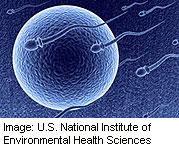- Skip Storing This Everyday Product in the Fridge Door
- Green Tea + B3 Pairing May Boost Brain Health
- Navigating Your Midlife Crisis: Embracing New Possibilities
- City Raccoons Showing Signs of Domestication
- Mapping the Exposome: Science Broadens Focus to Environmental Disease Triggers
- One Week Less on Social Media Linked to Better Mental Health
- Your Brain Changes in Stages as You Age, Study Finds
- Some Suicide Victims Show No Typical Warning Signs, Study Finds
- ByHeart Formula Faces Lawsuits After Babies Sickened With Botulism
- Switch to Vegan Diet Could Cut Your Greenhouse Gas Emissions in Half
Male Birth Control Shows Promise in Mice


A safe and effective male birth control pill may be inching closer to reality, according to researchers.
In laboratory experiments, mouse sperm was blocked from semen while still allowing for normal sexual activity. Without sperm in the ejaculated semen, there is no chance of fertilizing an egg and achieving pregnancy.
But women shouldn’t plan to abandon their birth control pills just yet. At least one expert said this new approach, although promising, is not ready for prime time and won’t be in the near future. Results of animal studies also don’t necessarily translate to humans.
For the study, researchers led by Dr. Sabatino Ventura, a senior lecturer at Monash University in Parkville, Australia, genetically knocked out two key proteins in mice. These proteins — alpha-1A adrenoceptor and P2X1-purinoceptor — transport sperm through the urethra when a man ejaculates, or releases semen.
These “double knockout” male mice were able to have sex normally with female mice, but there were no pregnancies despite ejaculation. In mice and other species, females form a plug in the vagina after successfully mating. In the new study, which was published online Dec. 2 in the journal Proceedings of the National Academy of Sciences, the female mice did not form a vaginal plug after mating, suggesting that the semen lacked sperm.
Previous attempts to develop a male birth control pill have focused on shutting down sperm production, a tricky and risky endeavor. “This approach is unique because it is nonhormonal and does not affect the development of sperm,” Ventura said.
“The sperm are fine, but they are just not transported at the appropriate time to be ejaculated,” he said.
As far as developing a male contraceptive pill based on these new findings, drug makers are already halfway there, Ventura said. Drugs currently on the market to treat benign enlargement of the prostate gland block the alpha-1A adrenoceptor protein.
“We just need a medicine to be developed for the second [protein] before a drug can be trialed,” he said. “The development of a drug for the second [protein] would most likely require a new molecule, followed by optimization, preclinical trials and then clinical trials.” He said this could take about 10 years.
If developed, this male contraceptive likely would be given as a daily pill just like the female birth control pill, Ventura said.
The new contraceptive would not have any negative hormonal or sexual side effects, Ventura said. “It is likely to be readily reversible so it can be used in young adults who still want to father children in later life,” he said.
When the researchers reversed the procedure and allowed the male mice to fertilize females, they found that the offspring were normal.
Dr. Natan Bar-Chama, a male reproductive urologist in New York City, said he is intrigued by the study but the findings should be viewed with caution. “The focus on the goal of achieving a safe male contraceptive is critically important,” said Bar-Chama, director of the Center for Male Reproductive Health at Reproductive Medicine Associates of New York.
Much hope has been pinned on possible male contraceptives in the past. Many attempts involved the male sex hormone testosterone, but Bar-Chama said these drugs failed to live up to their promise or caused serious side effects. Unacceptable side effects included altered sexual activity and irreversible changes in fertility.
“The new technique, while promising, raises some concerns,” Bar-Chama said. “We have a long way to go from showing that what happens in mice is usable in humans.”
Still, Bar-Chama is interested. “I applaud any effort to give couples options whereby the woman doesn’t have to take a hormonal contraceptive, and I look forward to seeing this further developed,” he said.
More information
Visit the U.S. Centers for Disease Control and Prevention for more about contraception.
Source: HealthDay
Copyright © 2025 HealthDay. All rights reserved.










